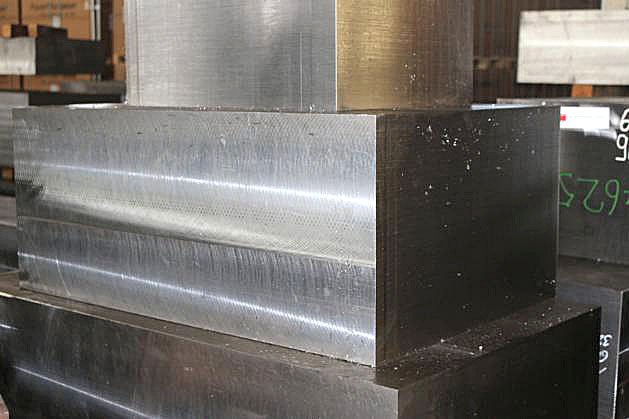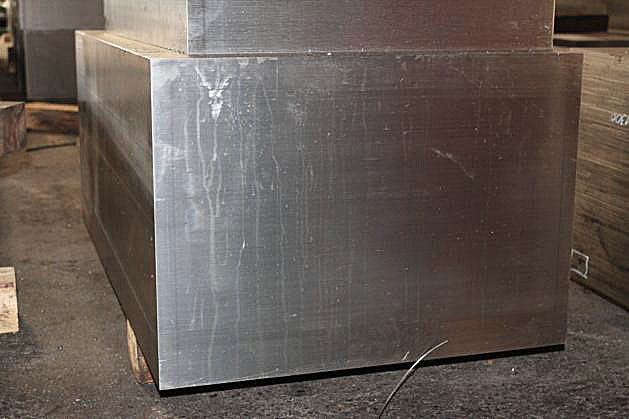1.4501 (ASTM A182 F55 - Superduplex: UNS S32760) buy steel from stock and cut to desired size
The 1.4501 is an austenitic-ferritic, high-alloy, low-carbon chromium-nickel-molybdenum-tungsten (super duplex) steel that is resistant to chloride-containing media and can be used in areas where traditional duplex steels are no longer adequate. Due to higher contents of chromium and molybdenum in combination with tungsten, the PREN-values of the material are from 40 to> 46 J with good impact values and wear resistance properties at -40 ° C. The steel 1.4501 - ASTM A182 F55 - Superduplex: UNS S32760 is resistant to seawater, has a high resistance to surface, as well as hole and crevice corrosion and is suitable to use in sulfuric acid.
1.4501 is listed under the classification AISI F55 according to ASTM A182 Grade F55 standardization.
For comparison: Duplex Steel or Super Duplex
Areas of application
The main applications of this stainless steel are among others, the chemical and petrochemical industry. Further applications are in desalination of seawater or brackish water (H₂S) areas, in food technology and shipbuilding (chemical tanker construction).
| Weldability | good |
| Machinability | 3 (1 = poor - 10 = good) |
| Polishing | yes |
| Corrosion class | 5 (0 = weak - 5 = good) |
Welding: The steel 1.4501 is weldable with all processes (TIG welding, MAG solid wire, arc welding, submerged arc welding). The exception is gas-melt welding! There is a risk of intermetallic compounds. Welding consumables, predominantly similar electrodes, should be used in welding, as they increase elongation properties at high temperatures. However, a change in the corrosion properties is to be expected in the area where the weld took place (heat-affected zone).
Forging: Before forging, the steel should be heated to 1150°C to 1180°C. The forging process takes place at 1200°C and 1000°C with subsequent air cooling. The surface treatment measures required for all rust- and acid-resistant steels are also valid for the 1.4501.
By homogenizing during the deformation process, local weak points of the alloying elements occurred, this is an advantage compared to cast materials.
Machining: Machining should be carried out in the solution-annealed condition, with low cutting speeds (20-40 [m / min] and low feed.) Due to the low thermal conductivity (due to high alloy contents), care must be taken to ensure sufficient cooling and the resulting tool life.
Corrosion resistance: This stainless steel has a very good corrosion resistance. Use in media causing pitting or stress corrosion cracking is possible because tungsten increases pitting resistance. The PREN values (chromium sum) can be> 40 according to the chemical analysis.
Polishing: Due to the two-phase ferrite-austenite structure, the resulting polishing pattern characteristic of this material changes.
Heat treatment
The heat treatment of the 1.4501 is carried out by solution annealing in the range 1040-1120°C with rapid cooling in sufficient water and this is also recommended after welding larger cross sections.
| Temperature | Cooling | |
| Hot forming | 1.200°C - 1100°C | Air |
| Heat treatment | ||
| Solution annealing (+ AT) | 1.040°C-1140°C | Water (quick cooling) |
Processing
| Cold forming | is possible |
| Cold diving | not common |
| Free-form and drop forging | is possible |
| Partial processing | partly possible |
| Automated machining | no |
Special features
Can be used in a temperature range between -45°C and 310°C
Magnetized
Physical Properties
| Density (kg/dm3 ) | 7,8 |
| Electr. Resistance at 20°C (Ω mm2 /m) | 0,8 |
| Thermal conductivity at 20°C (W/m K) | 15 |
| Specific heat capacity at 20°C (J/kg K) | 480-500 |
| 1.4501 | C | Si | Mn | P | S | Cr | Mo | Ni |
| min. | 24,0 | 3,00 | 6,00 | |||||
| max. | 0,030 | 1,00 | 1,00 | 0,035 | 0,01 | 26,0 | 4,00 | 8,00 |
| 1.4501 | V | Al | Cu | N | Nb | Ti | W |
| min. | 0,50 | 0,20 | 0,50 | ||||
| max. | 1,00 | 0,30 | 1,00 |
Flat steel, forged, solution annealed, quenched

The processing with the saw is a mechanical processing of the material, which results in a significantly lower unintended deformation and increased hardness for the existing structure, such as the thermal cutting.
Thus, the machined workpiece has a homogeneous structure even at the edge, which does not change in the continuation of the material.
This circumstance allows immediate finishing of the workpiece with milling or drilling. So it is not necessary to anneal the material or make a similar operation beforehand.
Do you have any questions?
We are happy to answer your questions and make you an offer for these and other materials. Contact us now for more information.

Your contact person Susann Dube+49 (0) 35263-665-31dube@stahlportal.com
Notice: Specifications contained in following data sheet are provided as a description, liability is excluded!
More stainless steel
| 1.4021 | 1.4057 | 1.4104 | 1.4112 |
| 1.4122 | 1.4313 | 1.4410 | 1.4418 |
| 1.4462 | 1.4542 | 17-4PH |




